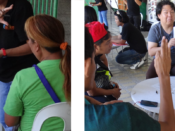After reaching out to low-literate communities in rural and urban Sri Lanka, we addressed another marginalized group in the Philippines: Deaf people. According to UNESCAP, people with disabilities have a 400% higher risk to die in hazard situations. One reason that holds especially for deaf people is the restricted access to formal education, which often leads to a significant lack in reading or writing skills. In a place like the Philippines, which is especially prone to natural disasters such as earthquakes and tropical storms, this can have severe consequences.

Together with our partners from the Deaf Disaster Assistance Team-Disaster Risk Reduction (DDAT-DRR), we conducted the study previously done in Sri Lanka, adapted to the Philippine situation. Currently, the results of the discussions are still being transcribed. However, we already noticed significant findings from the study. I want to share one example:
Due to their lack of hearing, deaf people are naturally very visual. So we encountered a situation we did not foresee: when talking to a group of elderly people (age 50+), we noticed that they dismissed most of the pictographs that had shown great acceptance in previous studies. The reason was that this group of people still felt traumatized by recent floods, and the pictographs shown exposed them to bad memories – so they felt awkward and did not want to see them.
So would those pictographs be “too good to be successful”? Can we accept to expose traumatized people to realistic visual descriptions, or would that undermine our efforts to use pictographs to get through to the marginalized communities? Definitely a research question to consider in our future work.


Leave a Reply